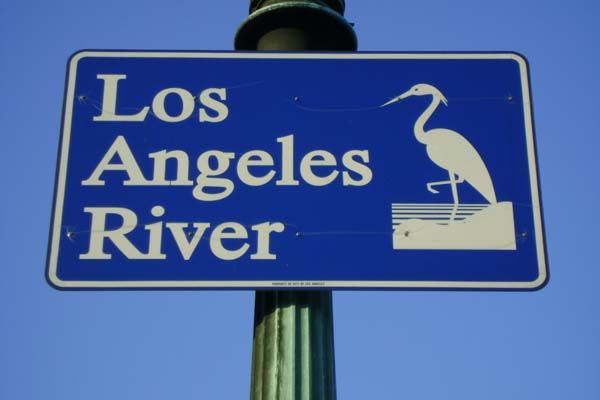Last week, City / Culture interviewed the Los Angeles-based Department of D.I.Y., a “growing group of discontented citizens” who are seeking increased civic safety, respect, and justice for the city’s bicyclists. The Department of D.I.Y. had previously peppered utility boxes around L.A. with visually arresting, wheat-pasted posters reading, “Caution! Please Pass With Care.”
Nationwide, May is a big month for bike-related events and proclamations, as Next American City’s Justin Glick points out here. Locally, the Los Angeles Police Department and the Los Angeles County Metropolitan Transportation Authority celebrated in part by releasing a 30-second video of Police Chief Charlie Beck urging asphalt kinship.
“We all share the road – cars, buses, trucks, and bicycles,” Beck says in the video. “But bicyclists are particularly vulnerable and need our protection, so be careful when you see them on the street. Always give them the right of way.” The Chief concludes: “It’s the law, and it’s the right thing to do.”
City / Culture sets out to chronicle creative folks doing work in urban settings, and in particular work that could at least arguably be done instead by government. The Department of D.I.Y. made it clear to City / Culture last week that its sign-making, while a creative campaign, is not intended to be read as a work of art. Los Angeles has a history of such hybrid projects that might be interpreted – or might be intended – as activism, as art, as municipal assistance, or as something in-between.
In 2001, downtown L.A.-based artist Richard Ankrom’s Guerilla Public Service created and mounted a Freeway sign that accurately and helpfully pointed out the best route from the 110 (Pasadena) Freeway to Interstate 5-North. The sign mimicked official highway visual nomenclature and endured in plain site alongside more officially produced signs for eight years. It was replaced in late 2009, but the new signage maintained – and in doing so, institutionalized – Ankrom’s useful addition.
The year prior to Ankrom’s work, a group called Heavy Trash took on a different aspect of Los Angeles-area transportation. Heavy Trash prepared eight appropriately portentous signs that trumpeted a new rail line (or perhaps, subway) “connecting downtown to the westside.” The signs resembled traditional transit maps, with ovals indicating station stops bisected by a horizontal and ocean-colored straight line. The signs also featured real street names and a bureaucratic-sounding – and fake – transit agency name. The signs also noted the project’s enticing title, Metro Aqua Line.
Why undertake the project? Heavy Trash wrote, “In Los Angeles, recent attempts at expanding the mass transit system have been shot down by community groups…. In response to this opposition, Heavy Trash created the Aqua Line to bring attention to the importance of mass transit in the hope of creating a united Los Angeles.”
A few years later, then-mayoral candidate Antonio Villaraigosa based a successful campaign in part on the promise of building down Wilshire Boulevard a “Subway to the Sea.” So, same as with the Ankrom sign, was this life imitating art – or just the zeitgeist, or common sense yearning winning out?
While the Subway to the Sea hasn’t yet happened, another, more southern, above ground east-west route called the Expo Line is under construction. And the East L.A to City of L.A. rail connector, the Gold Line Eastside Extension, opened recently.
The Eastside Extension crosses the L.A. River. Since the late 1930s, that body of water has been a concrete-straight jacketed flood channel. Meanwhile, the iconic writer, poet, filmmaker, performance artist, and raconteur Lewis MacAdams is more than halfway through an anticipated 40-year project to take the River back towards her more majestic heritage.
In the early 1980s, MacAdams did a performance art piece down amidst the concrete. In 1986, he and a few colleagues co-founded the Friends of the Los Angeles River, which has long since become a popular, family-friendly, and mainstream group. By three years ago, nearly every leading politician in the city was gathered en masse at a riverside open space, announcing plans – still undelivered – for billions of dollars worth of river revitalization.
Where does signage fit into this fish (or not) story? In 2004, MacAdams and another outsized local figure, the City Council member and tireless booster Tom LaBonge, are said to have cooperated to get the City to make and mount blue signs featuring a heron and reading, “Los Angeles River.” These signs, long sought, were posted on the various bridges citywide that cross the waterway. Local lore surrounding the signs includes this tale about a bottle of booze.
“People don’t recognize the L.A. River as a river,” that story’s author, the writer and activist Joe Linton told City / Culture last year. “So one early part of reclaiming it and revitalizing it and restoring it is to name it – instead of having people calling it “The Wash” or “Flood Control.”
So to recap this week’s subjects:
Furtive bicyclist advocates post the same message in secret that the Chief of Police delivers to the world. A guerilla artist makes a sign that becomes an accepted Freeway infrastructure improvement. Another group imagines, in public, a rail line that then starts to come true. And a performance artist and poet re-conjures a once mighty river, and years later, elected officials all fall in line.
It’s all so easy. Right?
Next week: Part II – Sign-spinning poetry, national parks as traffic islands, artists taking over commercial billboard, and still more about signs.
Read past City / Culture columns here (http://americancity.org/columns/category/city-culture/) and contact the columnist.



_920_518_600_350_80_s_c1.jpg)












